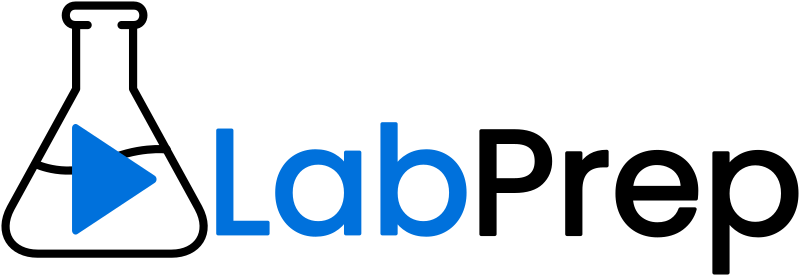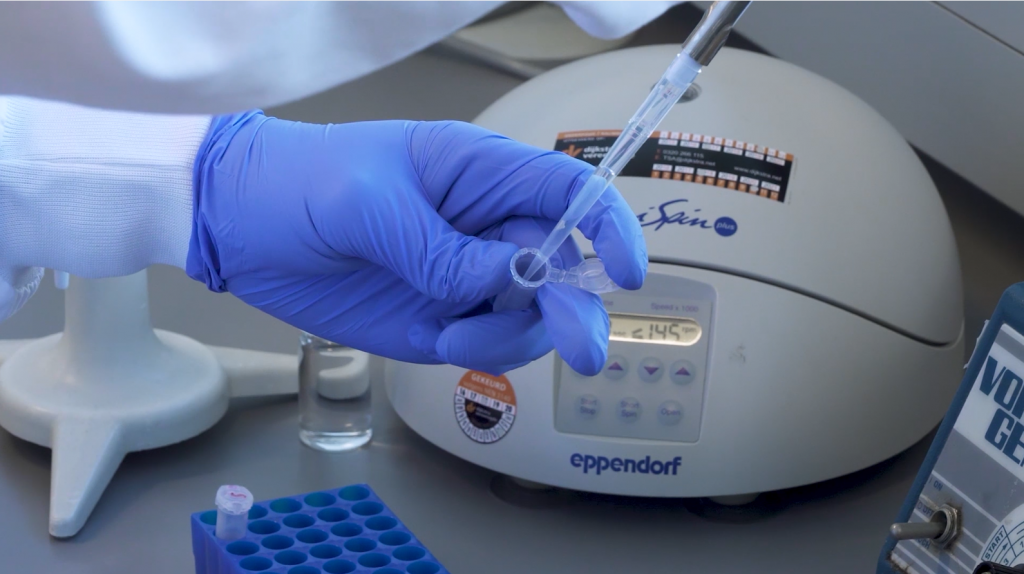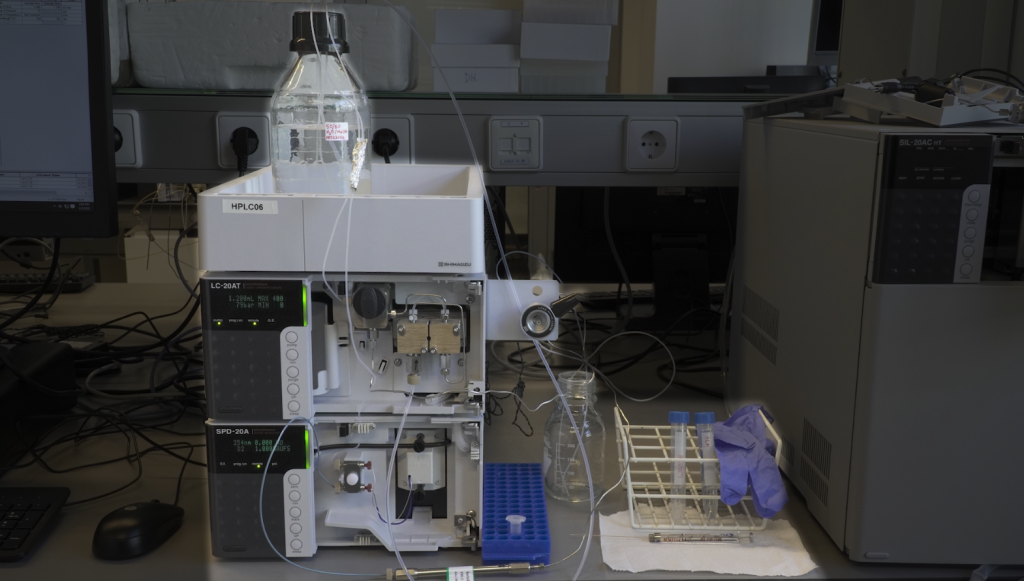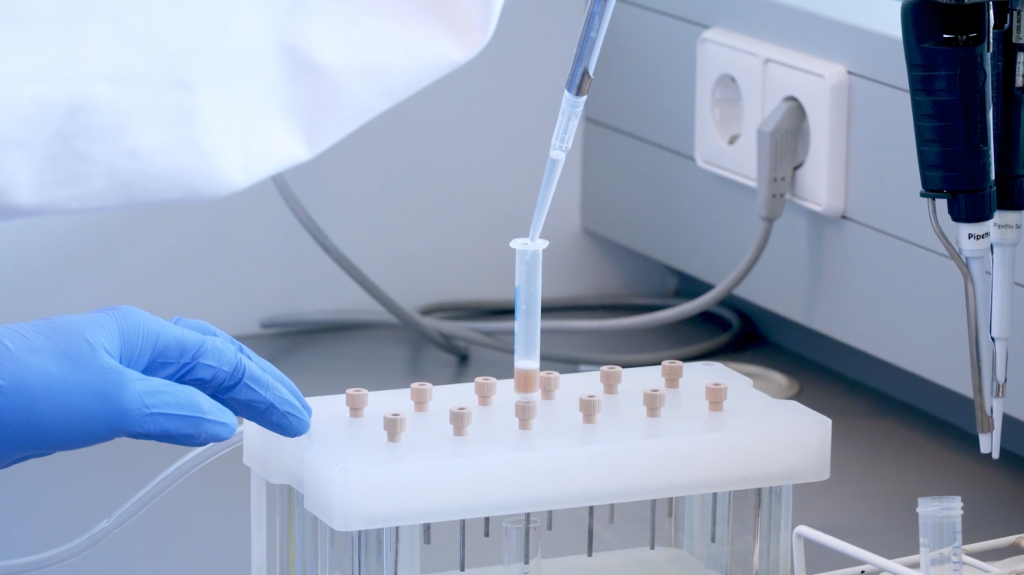HPLC-UV
Liquid chromatography is a fundamental method in analytical chemistry, which relies on retention of analytes on the stationary phase of a column. This video gives an overview of LC, shows detailed operating instructions for the LabSolutions software, and guides students through cleaning the sample loop and injecting their sample. This video was recorded to help students analyze their samples at the end of their first experiment. It was also used for subsequent experiments, when students had the freedom to adjust their mobile phases and separation parameters.
- Tineke Bijl
-
(0)
- 0 enrolled students
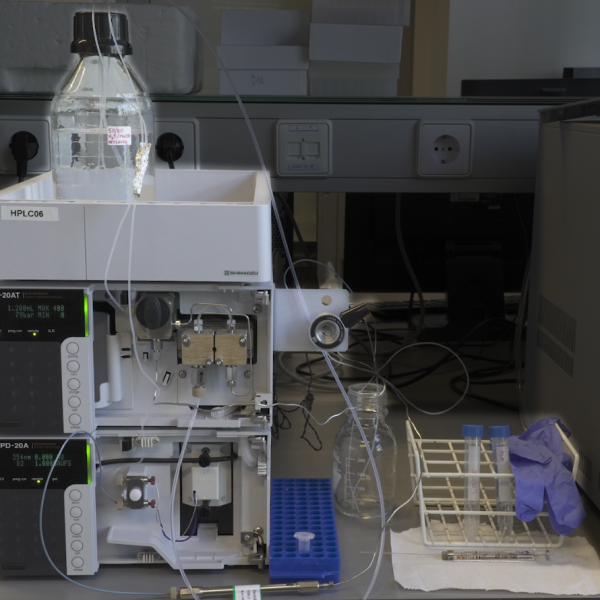
Description
Non-interactive video download link (mp4).
The script that has been used to create the video shown above can be downloaded as excel script file.
Start up HPLC | |
1 | Prepare 500 mL of your mobile phase. Your desired mobile phase composition (based on the HPLC simulator) is 40% methanol : 60% 20 mM acetate buffer pH 4.5. |
2 | Load your mobile phase into the HPLC system: screw the cap with the tubing on the bottle containing the mobile phase. |
3 | Open the LabSolutions software. |
4 | Click File and select a project folder with the date of today. (This ensures all your data files are saved in this specific folder). Create your new method file and save it. |
5 | The main part of your screen should look similar to this. The instrument parameter view shows the method you just opened. The LC graph shows the pressure in the system and can also show the absorbance from the UV detector. When you do not see both lines, ask an assistant for help. |
6 | Press download in the instrument parameter view. This means the method will also be send to the instrument. |
7 | Set the flowrate to 0.2. You can edit this in the settings box and press enter. |
8 | Turn on the pump by pressing the left button. Increase the flowrate in steps of 0.2 to the final flow rate. You can increase the flowrate to the next step when the pressure looks stable. |
9 | When you reach the final flowrate, the system has started up and you can proceed with the measurements. |
Analyze sample with HPLC-UV | ||
1 | Reconstitute your sample in 1 mL of the mobile phase you have prepared. | |
2 | Rinse the needle 3x with acetonitrile. | |
3 | Rinse the injection loop 3x by injecting acetrontrile. | |
4 | Fill the needle with 25 µL of sample. | |
5 | Inject the sample in the injection loop, start single run on the PC, switch the trigger to inject and back. | |
6 | Save your results. | |
7 | Redo the analysis to test what mobile phases and detection wavelengths work best. Test at least 2 different mobile phases and at least 3 different detection wavelengths. | |
8 | Gradually reduce the flow rate until it is back at 0.01 mL/min. Empty the waste bottle, and return the outlet tubes to the mobile phase bottle, so that the system continues to flush overnight. | |
- In liquid chromatography, the samples move through a column, this column is the [stationary phase].
Feedback if incorrect: You have not labelled the column correctly. In chromatography there is a phase that moves and a phase that is stationary. Does the column ‘move’?
- The liquid that passes through the column is the [mobile phase].
Feedback if incorrect: You have not labelled the liquid correctly. In chromatography there is a phase that moves and a phase that is stationary. Does the liquid ‘move’?
- In our case, the [answer_polar] is polar, and the [answer_apolar] is apolar.
Feedback if incorrect: You have not labelled the liquid correctly. In ‘normal’ liquid chromatography the column material is more polar than the mobile phase.
- In reverse phase chromatography it is the other way around. Check the column material and mobile phase in the list above. Analytes with a higher affinity with the [answer_higher] than the [answer_than_the] move through the column faster and arrive at the detector first.
Feedback if incorrect: Your answer regarding how affinity of the analytes with the phases determines what analyte runs off the column first is incorrect. Think of it like this: if the analyte rather ‘likes’ the stationary phase, it would ‘rather’ stay in the column then move along with the mobile phase.
Feedback if all answers Correct: The stationary phase, the column, should (slightly) repel the analytes to make them move through the column. Analytes that have higher affinity with the mobile phase than the stationary phase will run off the column and reach the detector first.
Each part of the HPLC-system serves its own purpose. Indicate what by selecting the right parts in the list below:
- This is what transports the sample through the column: [a] Mobile phase
Feedback if Incorrect. The sample is brought through the system by the mobile phase. - This is what releases your sample to be sent to the column. [b] Trigger
Feedback if Incorrect. The sample is brought into the system by injection using a syringe. - This ensures the right mobile phase flowrate. [c] Pump
Feedback if Incorrect. What part of the system ensures the speed at which the sample flows through the system? - This is where analyte separation takes place. [d] Column
Feedback if Incorrect. The purpose of the liquid chromatography is to separate the analytes so that they can be detected separately. The separation takes place in the column (as long as the right conditions are set). - This is the device that measures the analytes. [e] Detector
Feedback if Incorrect. Your final answer is wrong.
The sample is injected into the injection loop. Then the system switches and the mobile phase brings the sample through the column where separation of the analytes takes place.
Feedback if correct: The sample is injected into the injection loop.
Then the system switches and the mobile phase brings the sample through the column where separation of the analytes takes place.
At the end of the column, a detector registers the samples.
What mobile phase composition would you like to use? And what percentage of organic modifier would you like to add?
[a____] % [20 mM acetate buffer pH 4.5 / 0.1% formic acid pH 2.7 / 20 mM phosphate buffer pH 7.0/ ammonium buffer pH 9.0]: [b____] % methanol
- Feedback if a + b = NOT 100:
These percentages don’t add up to 100%! That can’t be right. - Feedback if b < 5:
This percentage of methanol is very low! Are you certain this would lead to the desired separation based on your simulations using the HPLC simulator?
- Feedback if b > 75:
This percentage of methanol is quite high! Are you certain this would lead to the desired separation based on your simulations using the HPLC simulator?
Feedback if correct:
Your desired mobile phase composition (based on the HPLC simulator) is [percentage_methanol]% methanol : [percentage_aqueous]% [chosen mobile phase]
In which order do you expect the parabens to elute? Place the first one on top.
Correct answer:
- 1 Methyl paraben
- 2 Ethyl paraben
- 3 Propyl paraben
- 4 Butyl paraben
- Feedback if correct
Molecules with the highest affinity to the stationary phase will run off the column last. As you have determined earlier, methyl paraben has the highest water solubility, from which you can conclude it has the least affinity to the apolar stationary phase.
This in contrast to the least water soluble paraben butyl paraben, that probably runs off the column last.
- Feedback if incorrect
Incorrect. Consider the properties of the HPLC column and the properties of the analytes.
What requirements should the analytes have to make them suitable for analysis with liquid chromatography equipped with a UV-detector?
- They should emit UV light
Correct = no
You chose a wrong option. The LC system is equipped with a UV detector which is similar to a spectrophotometer. UV light is emitted through the sample and absorption at UV-wavelength is recorded.
- They should absorb UV light
Correct = Yes
- They should be fluorescent
Correct = no
You chose a wrong option. The LC system is equipped with a UV detector which is similar to a spectrophotometer. The analytes might be fluorscent but here the absorption is measured and not the emission of light.
- They should have affinity with the solid phase of the column
Correct = Yes
- They should be able to dissolve
Correct = Yes
- They should be stable at solvent boiling point
Correct = no
You chose a wrong option. In liquid chromatography, the samples are not evaporated, hence the term liquid. The analyzed sample will not reach boiling point.
- They should be liquid at room temperature
Correct = no
This is not necessarily the case. The liquid in liquid chromatography refers to the mobile phase. As long as the analytes can be dissolved, their phase in pure form at room temperature (solid, liquid or gas) is not really relevant.
Feedback if all correct options chosen:
You want separation of the analytes to take place, so that you can detect them separately. Here a UV-detector is suitable as all analytes absorb light in the UV-spectrum.
The needle used for injection of the sample into the chromatography system needs to be rinsed to remove any impurities or molecules that might interfere with the separation.
What are the properties that would make a solvent the most suitable for this?
- Cheap
Correct = yes
- Miscible with water
Correct = yes
- Immiscible with water
Correct = yes
- Hydrophobic
Correct = no
The purpose is to remove any impurities or molecules that might interfere with the separation. What if there are water molecules present in the needle? Wouldn’t you want to remove those too? One or more of the properties you have selected now is in conflict with this.
- Hydrophilic
Correct = no
The purpose is to remove any impurities or molecules that might interfere with the separation. What if there are water molecules present in the needle? Wouldn’t you want to remove those too? One or more of the properties you have selected now is in conflict with this.
- A strong acid
Correct = no
The purpose is to remove any impurities or molecules that might interfere with the separation. Any acid or base properties are not relevant here, as long as you keep the purpose in mind.
- A strong base
Correct = no
The purpose is to remove any impurities or molecules that might interfere with the separation. Any acid or base properties are not relevant here, as long as you keep the purpose in mind.
- Low boiling point (<70°C)
Correct = no
The purpose is to remove any impurities or molecules that might interfere with the separation. The actual boiling point of the solvent used is not really relevant, as long as it is a liquid at room temperature, right?
- High boiling point (>70°C)
Correct = yes
- Aqueous
Correct = no
The purpose is to remove any impurities or molecules that might interfere with the separation. The actual boiling point of the solvent used is not really relevant, as long as it is a liquid at room temperature, right?
- Organic
Correct = no
The purpose is to remove any impurities or molecules that might interfere with the separation. If your solvent is aqueous, you might not remove any hydrophobic impurities. Therefore an aqueous solution would not be suitable.
- Safe to use
Correct = yes
Feedback if all correct options:
The purpose is to wash any impurity away, so ideally both polar and non-polar compounds dissolve in the solvent used. Also you want it to be cheap and safe to not waste any money or take unnecessary risks.
Download LabBuddy import file start-up HPLC system
Download LabBuddy import file analyze with HPLC system
Please make sure that your product exists and valid for this course
- Skill levelIntroduction video
- CategoryAnalytical chemistry
Related videos
-
Free
HPLC-UV
Copyright information
This video is created by Leiden Academic Centre for Drug Research (LACDR), Faculty of Science at Leiden University under a open Creative Commons Attribution-NonCommercial-ShareAlike 4.0 International License. When using this video in its original version please refer to www.labprep.video. When adapting the video, mention the source ‘adapted based on the original version that is created by the labprep.video team’. It is not allowed to use the video for commercial purposes without consultation with the creators. You can contact us via info@labprep.video.
